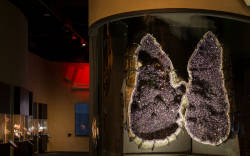Geodes
Vugs



The term geode or vug is commonly used in mineralogy to describe a cavity that is filled with crystals. It is a filling with mineral or fossil substance created by various geological processes. Often a residual cavity remains when filled with crystals, sometimes it is completely filled.
Most mineral collectors, however, have a very special sub-type in mind, a sphere or spherical form usually filled with quartz varieties such as amethyst or agate. Although this is a special form, it is easy to see how it was formed. A rock, in this case of volcanic origin, has a multitude of cavities, in this case gas bubbles in the lava that remained as cavities when the lava solidified. Groundwater dissolves minerals from the surrounding rock and recrystallises them in the opening. This happens very slowly and so the molecules and ions have time to align themselves optimally and form regular structures, which are called crystals. If the surrounding rock is now dissolved by weathering, the fillings remain longer because they are made of more resistant material. It is obvious why the outside is mostly closed, the crystals have grown on the wall of the cavity and covered it completely. Then they have grown inwards, and when they have had enough time the interior is completely filled.
At showcaves.com we specialise in caves, not minerals. But if such a structure is large enough for a human to crawl inside, it would meet the definition of a cave. And indeed, various such caves have been found over time. Some are so fragile that they are either inaccessible or were quickly destroyed. Others have been considered as mineral resources and have been mined. But especially in recent years, some very special specimens have been opened to the public. And even if their specialness is usually not understood by visitors, they are usually so extraordinary that they quickly become famous.
The geodes described above, which are formed from solidified bubbles in volcanic rocks, are a special type sold by the thousands, perhaps millions, at mineral fairs around the world. The large ones that can be called caves are formed by all imaginable processes of cave formation. Most are of volcanic origin, but tectonic movements are also an important process for the formation of underground cavities. Karst caves, on the other hand, are mostly responsible for the drainage of the area, so stagnation for hundreds of thousands of years is rather unlikely.
- Examples
 Naica Crystal Caves - Cueva de las Espadas - Cueva de los Cristales
Naica Crystal Caves - Cueva de las Espadas - Cueva de los Cristales Heineman Winery - Crystal Cave
Heineman Winery - Crystal Cave Kristallkluft Gerstenegg
Kristallkluft Gerstenegg Kristallhöhle Kobelwald
Kristallhöhle Kobelwald Marienglashöhle
Marienglashöhle La Geoda de Pulpí
La Geoda de Pulpí Erlebnis Bergwerk Merkers
Erlebnis Bergwerk Merkers Jewel Cave
Jewel Cave Grotta di Santa Barbara
Grotta di Santa Barbara
 Search DuckDuckGo for "Geodes"
Search DuckDuckGo for "Geodes" Geode - Wikipedia (visited: 17-SEP-2021)
Geode - Wikipedia (visited: 17-SEP-2021)
 Index
Index Topics
Topics Hierarchical
Hierarchical Countries
Countries Maps
Maps